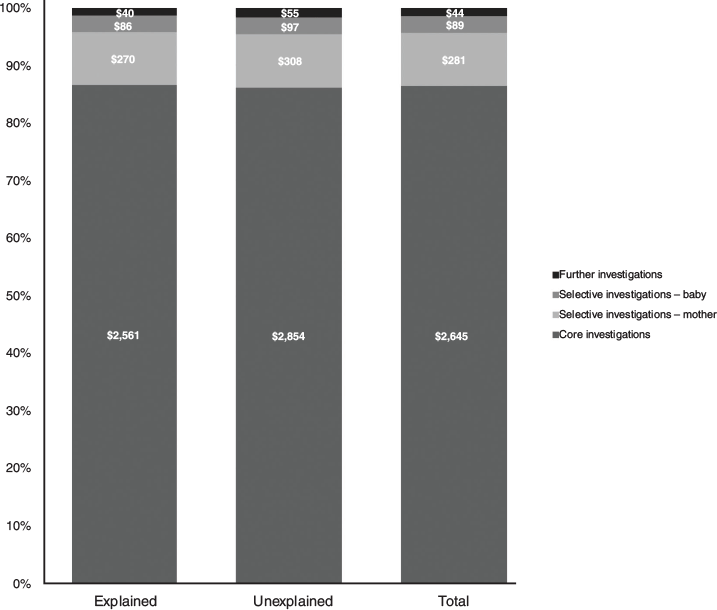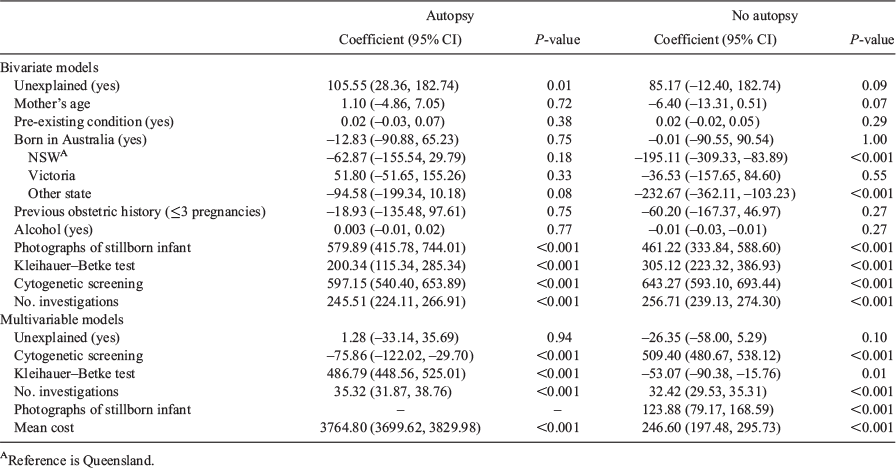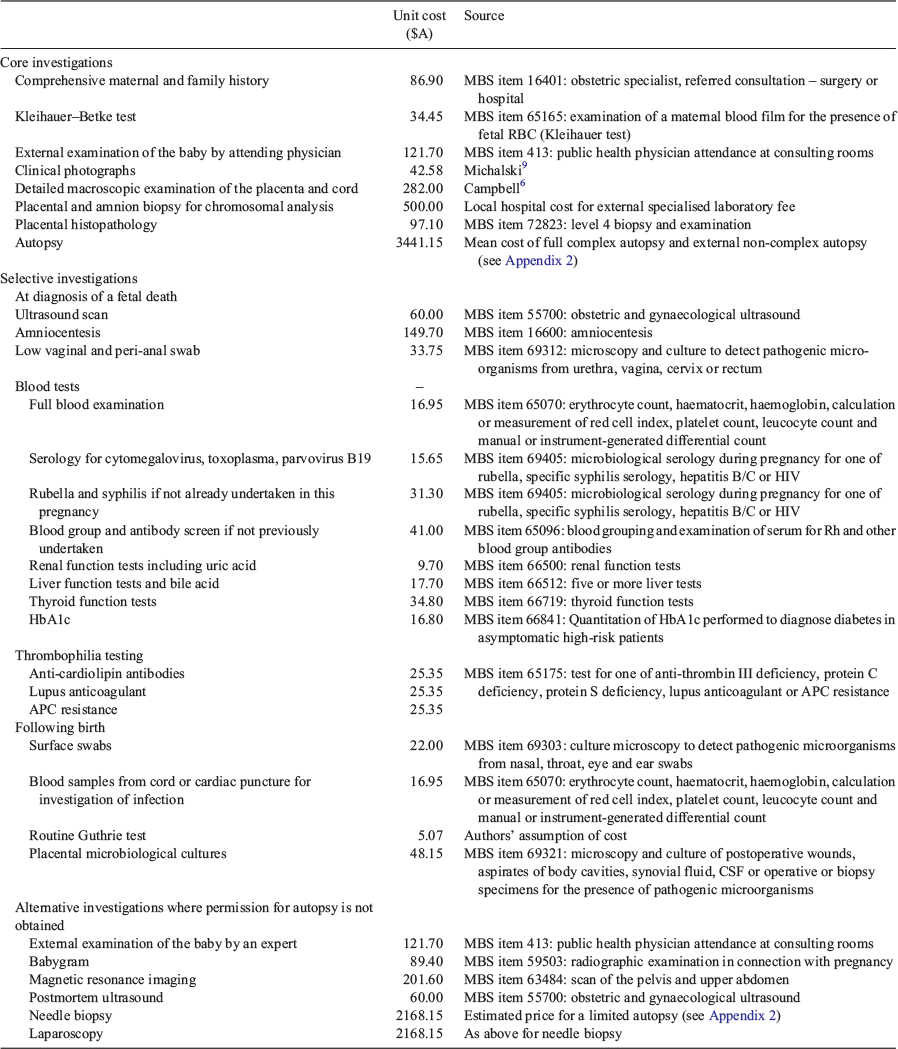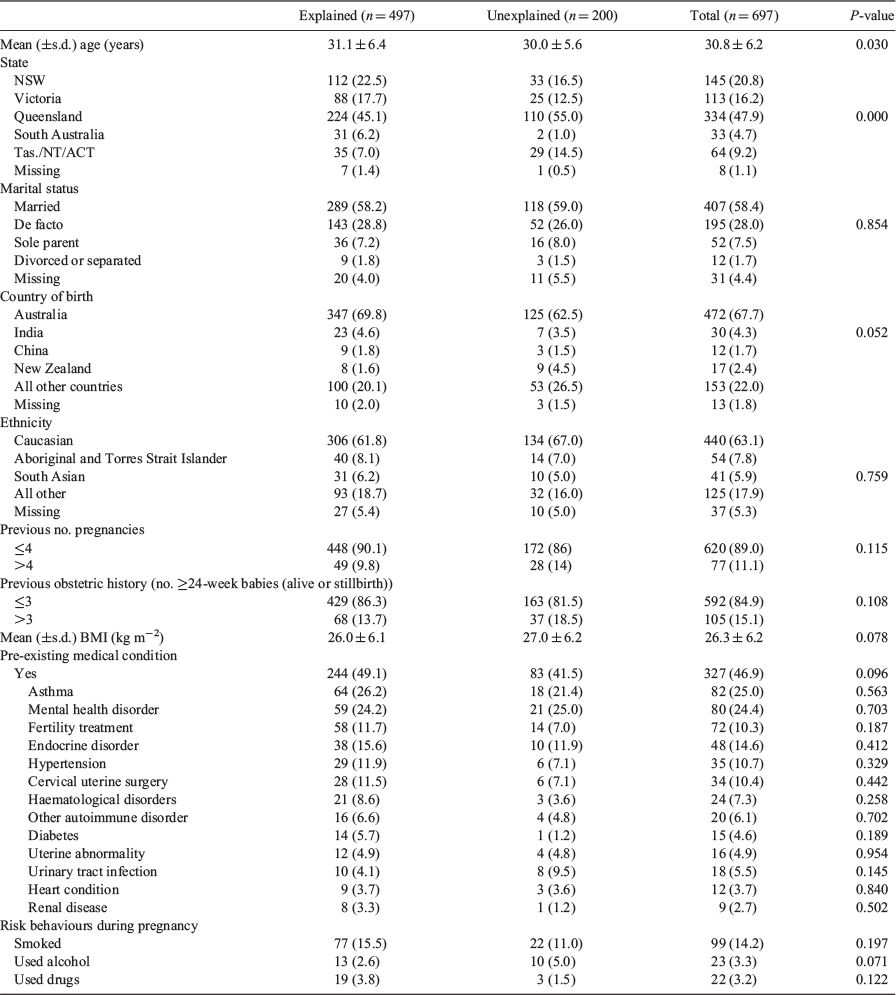Healthcare costs of investigations for stillbirth from a population-based study in Australia
Louisa G. Gordon A B C H , Thomas M. Elliott
A B C H , Thomas M. Elliott  A , Tania Marsden D E , David A. Ellwood E F , T. Yee Khong E G , Jessica Sexton D E and Vicki Flenady D E
A , Tania Marsden D E , David A. Ellwood E F , T. Yee Khong E G , Jessica Sexton D E and Vicki Flenady D E
A QIMR Berghofer Medical Research Institute, Population Health Department, Locked Bag 2000, Royal Brisbane Hospital, Herston, Qld, Australia. Email: thomas.elliott@qimrberghofer.edu.au
B School of Nursing and Institute of Health and Biomedical Innovation, Queensland University of Technology, Kelvin Grove, Qld, Australia.
C The University of Queensland, School of Public Health, Herston, Qld, Australia.
D Mater Research Institute, The University of Queensland, Brisbane, Qld, Australia. Email: t.marsden@uq.net.au; jessica.sexton@uq.edu.au; vicki.flenady@mater.uq.edu.au
E National Health and Medical Research Council (NHMRC) Centre for Research Excellence in Stillbirths, South Brisbane, Qld, Australia.
F Griffith University, School of Medicine, Gold Coast, Qld, Australia. Email: d.ellwood@griffith.edu.au
G Women’s and Children’s Hospital, Adelaide, SA, Australia. Email: Yee.Khong@adelaide.edu.au
H Corresponding author. Email: louisa.gordon@qimrberghofer.edu.au
Australian Health Review 45(6) 735-744 https://doi.org/10.1071/AH20291
Submitted: 8 October 2020 Accepted: 9 March 2021 Published: 28 October 2021
Journal Compilation © AHHA 2021 Open Access CC BY-NC-ND
Abstract
Objective Stillbirth investigations incur healthcare costs, but these investigations are necessary to provide information that will help reduce the risk of a recurrent stillbirth, as well as advice regarding family planning and future pregnancies. The aims of this study were to determine the healthcare costs of investigations for stillbirths, identify drivers and assess cost differences between explained and unexplained stillbirths.
Methods Data from 697 stillbirths were extracted from the Stillbirth Causes Study covering the period 2013–18. The dataset comprised all investigations related to stillbirth on the mother, baby and placenta. Unit costs applied were sourced from the Australian Medicare Benefits Schedule, local hospital estimates and published literature. Multivariable regression analyses were used to assess key factors in cost estimates.
Results In all, 200 (28.7%) stillbirths were unexplained and 76.8% of these had between five and eight core investigations. Unexplained stillbirths were twice as likely to have eight core investigations as explained stillbirths (16.5% vs 7.7%). The estimated aggregated cost of stillbirth investigations for 697 stillbirths was A$2.13 million (mean A$3060, median A$4246). The main cost drivers were autopsies or cytogenetic screening. Mean costs were similar when stillbirths had known or unknown causes and by reason for stillbirth among cases with definable causes.
Conclusion Investigations for stillbirth in Australia cost approximately A$4200 per stillbirth on average and are critical for managing future pregnancies and preventing more stillbirths. These findings improve our understanding of the costs that may be averted if stillbirths can be prevented through primary prevention initiatives.
What is known about the topic? Approximately 2000 stillbirths occur each year in Australia, and this trend has not changed for several decades. Stillbirth investigations incur healthcare costs, but these investigations are necessary to provide information to help reduce the risk of a recurrent stillbirth and advice regarding family planning and future pregnancies. Recommendations for the core set of stillbirth investigations have recently been agreed upon by consensus.
What does this paper add? The costs of stillbirth investigations are unknown in Australia. The assessment of these costs is challenging because not all investigations involved in stillbirths are recorded within formal administrative systems because a stillborn baby is not formally recognised as a patient. The present population-based analysis of 697 stillbirths in Australia estimated that, on average, A$4200 was spent on investigations for each stillbirth, with key drivers being autopsies and cytogenetic screening. These costs are typical, with most cases having between five and eight of the core eight recommended investigations.
What are the implications for practitioners? There are cost implications for stillbirth investigations, and this analysis gives a true account of current practice in Australia. Together with the high downstream economic costs of stillbirths, the cost burden of stillbirth investigations is high but ultimately avoidable when practitioners adhere to the core investigations, build knowledge around preventable risk factors and use this information to reduce the number of stillbirths.
Keywords: cost analysis, fetal autopsy, health economics, high-risk pregnancies, investigations, prevention initiatives, stillbirths, unexplained stillbirth.
Introduction
Each year there are approximately 2100 stillbirths in Australia, equating to 6.8 per 1000 pregnancies or six stillbirths per day.1 This rate is similar to that in other developed countries, and has stabilised over two decades despite significant parallel improvements in childhood mortality rates.2 Stillbirths are a deeply emotional and painful experiences for parents, who often experience long-term psychological effects. Although the causes of most stillbirths are known, approximately 20% of all stillbirths are unexplained despite intensive testing.1 An unexplained stillbirth creates problems in terms of inadequate closure for parents, planning subsequent pregnancies and the psychological well-being of parents. Yet, there is still a lack of attention and research in monitoring and understanding why these events occur to enable effective prevention initiatives.3
In Australia, stillbirths are classified according to the Perinatal Society of Australia and New Zealand (PSANZ) Perinatal Death Classification (PDC) Clinical Practice Guideline.4 According to the most recent national report based on five states and territories (representing 60% of all perinatal deaths), the most common cause of deaths was congenital anomalies (31%), followed by spontaneous preterm birth (14%) and unexplained antepartum death (12%).5 There may also be multiple causes of a stillbirth, making single classifications difficult. Performing more investigations to find the cause of an unexplained stillbirth may or may not result in a definitive diagnosis, but it will increase healthcare costs. Although there is no consensus on the recommended stillbirth investigation protocols across countries, there appears to be general agreement on a core set of investigations in Australia, and these have culminated in new clinical guidelines.4 If necessary, further investigations are optional depending on the results of the core investigations.
Several studies have described the costs of stillbirths in various countries.6–10 Compared with live births, additional healthcare costs of US$2000–5000 have been reported.6–10 Although additional investigations will increase direct healthcare costs in the immediate term, they are necessary to provide: (1) information that will help reduce the risk of recurrent stillbirths; and (2) advice with family planning and future pregnancies. Approximately 52% of mothers who have had a stillbirth are pregnant again within 12 months.6 Fully understanding the scope and value of stillbirth investigations may avoid unnecessary costs to the health system associated with autopsy costs, bereavement counselling and future high-risk pregnancies.
In 2019, the PSANZ recommended eight core investigations (unless the cause of death was unequivocally determined antenatally).4 Optional additional investigations could be undertaken subject to information revealed from the core investigations. The core investigations are: (1) comprehensive maternal (medical, social and family) and pregnancy history; (2) Kleihauer–Betke test/flow cytometry for fetal-to-maternal haemorrhage; (3) external examination of the baby performed by the attending clinician; (4) clinical photographs of the baby; (5) autopsy (full or limited); (6) detailed macroscopic examination of the placenta and cord; (7) placental histopathology; and (8) cytogenetic screening (chromosomal microarray or karyotype).
The aim of the present study was to evaluate the costs of stillbirth investigations in Australia using data from the Stillbirth Causes Study.11 With a focus on the core PSANZ investigations, we determined the costs of actual tests and investigations on a large cohort, assessed differences among explained and unexplained stillbirths and identified factors that could explain any cost differences.
This study was approved by the Mater Health Services Human Research Ethics Committee and all collaborating clinical sites (HREC/1745M).
Methods
The cost analysis is based on a cohort of 697 prospective stillbirth cases entered into a purpose-built Stillbirth Causes Study database. Data were extracted from the database covering the period 2013–18. The registry was newly established in 2013 and included consecutive cases of stillbirth (≥20 weeks gestation or ≥400 g birthweight excluding terminations of pregnancy) from 18 maternity hospitals in Australia. Although the PSANZ 2019 stillbirth investigation guidelines were ratified after the study cases were entered, we were interested in current testing levels against the new guidelines to indicate baseline adherence. Prior to 2019, earlier PSANZ guidelines12–14 recommended more comprehensive testing. The dataset provided detailed records on stillbirths, the mother’s sociodemographic profile (e.g. age, marital status, occupation, education, ethnicity, country of birth, history of smoking and drug use), obstetric history, body mass index (BMI), previous pregnancies, maternal outcome and the investigations undertaken for determining the cause of the stillbirth. Details on the baby included sex, body measurements and the results of the investigations.
The dataset comprised all investigations related to stillbirth on the mother, baby and placenta. Hospitals were required to submit data into an online database for the National Perinatal Death Clinical Audit Tool Confidential Report and Investigations supplement. Due to the design of the data entry (mandatory fields), most variables were very complete. If no data were recorded for an investigation, it was presumed that it was not performed. The PSANZ-PDC system was used to classify the cause of death for all stillbirths. Where the cause of death classification was missing (<4%), the study coordinating site classified the cause of death using all available study data, including the clinical database, autopsy reports and/or pathology reports. Any missing data are the result of either clerical error or the absence of final reports at the time the case was entered into the database.
The investigations recorded in the dataset and included in the analysis were categorised according to the PSANZ guidelines as:
-
core investigations (maternal and pregnancy history, Kleihauer–Betke test, external examination of the baby, clinical photographs, autopsy, placental examination, placental histopathology and cytogenetic screening)
-
selective investigations (based on findings of core investigations: ultrasound, amniocentesis, vaginal swabs, blood tests (full blood count, viruses, bacteria, blood group, renal/liver and bile acids/thyroid tests, HbA1c, drug screen), thrombophilia tests; post-birth investigations on the baby: surface swabs, cord blood samples, blood for chromosomal analysis, Guthrie test, placental microbiological cultures)
-
alternative investigations (when permission for a full autopsy was not obtained: external baby examination, babygram, magnetic resonance imaging, postmortem ultrasound, needle biopsy and laparoscopy).
The unit costs applied to each investigation were sourced from the Australian Medicare Benefits Schedule (MBS) reimbursement codes, local hospital estimates and published literature (Appendix 1). Not all investigations involved in stillbirths are recorded within formal administrative systems because a stillborn baby is not formally recognised as a patient; therefore, it was necessary to rely on pathology advice. The cost of autopsy is highly variable depending on whether a full or limited autopsy is performed and the different set of investigations used. We applied a simple average of A$3441.15 of the highest and lowest cost examples as a reasonable estimate of the mean autopsy cost. Specific details are provided in Appendix 1.
Statistical analysis
Descriptive analyses were performed on the mother’s sociodemographic and clinical data using frequencies and percentages for categorical data and the mean ± s.d. for continuous data. Costs for core, selective and alternative investigations, as well as total costs (combined costs), were summarised as the mean ±s.d., median value and range (minimum–maximum values). Sociodemographic and clinical data were stratified by ‘explained’ versus ‘unexplained’ stillbirths, and the significance of differences was tested using Pearson’s Chi-squared tests or Student’s t-tests for categorical or continuous data respectively.15 Total costs had a distinct bimodal distribution where cases with or without an autopsy had high or low costs respectively. Therefore, ordinary least-squares regressions were performed for the autopsy and non-autopsy groups separately. Sociodemographic and treatment variables were assessed in bivariate models and were excluded from multivariable regression based on their statistical significance, which was set at two-tailed P < 0.05. Model goodness of fit was based on the adjusted R2. All analyses were performed in Stata SE version 15 (StataCorp, College Station, TX, USA).
Results
The mean age of the mothers was 30.8 ± 6.2 years, and two-thirds were Australian born (Table 1). Over half the mothers were married (58%) or in a de facto relationship (28%); 48% resided in Queensland. Women identifying as Caucasian made up 63% of the sample, 8% identified as Aboriginal and Torres Strait Islander, 6% identified as South Asian and 18% were a mix of other ethnicities. Among all women, 11% had had more than four previous pregnancies, and the mean BMI was 26.3 kg m−2 (with a BMI of 25–29.9 kg m−2 considered overweight). The most common pre-existing medical conditions reported were asthma, a mental health disorder, fertility treatment, an endocrine disorder and hypertension. A small number of women reported smoking (14%) or using alcohol (3%) or drugs (3%) during pregnancy. Queensland mothers, younger age and those born outside Australia had higher frequencies of unexplained stillbirths (Table 1).
Of all stillbirths, 200 (28.7%) were unexplained. Overall, 76.8% of cases had between five and eight core investigations. Cases of unexplained stillbirths had higher frequencies of Kleihauer–Betke testing, clinical photographs and cytogenetic screening (Table 2). Unexplained stillbirths were twice as likely to have all core investigations as explained stillbirths (16.5% vs 7.7%; Table 2). Various causes of stillbirths were recorded, including hypoxic peripartum death (1.8%) and congenital abnormalities (17.5%; Table 2).

|
The total cost of stillbirth investigations for 697 stillbirths was A$2.13 million (mean $3060, median $4246, range $35–5639). Core investigations accounted for 86% of total costs (A$1.84 million; mean $2645, median $3941, range $0–5639; Fig. 1). All other non-core investigations cost A$28 8916 (13.5% of total costs). The main cost drivers were for autopsies and cytogenetic screening.

|
The unadjusted results revealed mean costs for the autopsy and non-autopsy groups of $4840 ± 342 and $1067 ± 383 respectively. After adjustment for cytogenetic screening, Kleihauer–Betke tests, photographs and the number of investigations performed, the costs in the autopsy and non-autopsy groups were $3765 (adjusted R2 = 0.811; n = 363) and $247 (adjusted R2 = 0.903, n = 334) respectively (Table 3). Regardless of an autopsy being performed, costs were not affected by whether the stillbirth cause was unknown within these groups. However, assessing the breakdown among cases with known causes for stillbirth, costs were significantly lower, by approximately $193, in the non-autopsy group if the cause was a specific perinatal condition or spontaneous preterm birth (Table 4).

|

|
Discussion
We estimated the healthcare costs of stillbirth investigations from a large Australian sample covering a wide representation of hospitals. The mean estimated investigation cost to the health system was A$4200 per stillbirth, with 76% of stillbirths having five to eight core investigations. The major determinant of costs was whether an autopsy was undertaken. Aside from autopsy and other recommended core investigations, we found costs were not associated with sociodemographic or medical factors that could indicate differences in the health care provided to mothers who had a stillbirth.
Although, until recently, there were many possible investigations to determine the cause of stillbirth, the PSANZ guidance has formalised the essential minimum by recommending eight core investigations, made by consensus and ratified in 2019.4 This is after the time stillbirth cases were entered into the database used in the present study, so there was no opportunity for dissemination of the PSANZ guidelines to improve clinical practice. Despite this, a high proportion of cases (76%) undertook most of the core investigations. This would include some cases that would not have required all the core investigations due to an unequivocal cause, with further tests deemed unnecessary. Our findings represent a baseline understanding of overall health system costs, training requirements for physicians and current clinical practices before the PSANZ guidelines. These results offer a benchmark for ongoing professional education and research by emphasising the burden of stillbirths and the role of diagnostic information in optimising resources for future clinical management.
Other cost-analyses of stillbirths have reported varied findings using different approaches and cannot be directly compared with the findings of the present study, which are a subset of overall stillbirth costs. Callander et al. assessed costs to the Australian government and reported an excess of A$3774 for stillbirths compared with healthy births and an additional A$1479 in out-of-pocket costs to mothers.16 That study excluded costs of stillbirth investigations, and so complements the present study. Together, the findings of the present study and those of Callander et al.16 suggest that each stillbirth case in Australia may have a full economic cost of approximately A$7900. In the UK, the cost of stillbirth investigations was £1804 (2020 A$4218), which included counselling services,10 and the total cost of stillbirth to the National Health Service was £41916 (2020 A$8698). Earlier US findings from 2002 estimated the total direct and indirect costs of stillbirth at US$1447 (2020 A$2675), of which 45.5% was for indirect costs;9 later research in 2013 reported a mean (±s.d.) hospital cost of US$7495 ± 7015) (2020 A$11 429 ± 10 697) for each stillbirth.7
Currently, it is difficult to draw conclusions about whether additional testing and higher costs are worthwhile when each stillbirth is assessed on a case-by-case basis. The marginal costs of each subsequent test and deeper analysis of stillbirth predictors and causes will enable a more detailed value assessment. Based on our findings, crude extrapolation would suggest Australia pays A$8.8 million per year in stillbirth investigations or A$28 per live birth (based on 315 000 annual live births17). Although this may seem high, it is worth noting that stillbirth investigations have a high diagnostic yield, and many diagnoses are amenable to prevention or changes to management for subsequent pregnancies (e.g. diabetes and hypertension management, folate supplements, additional antepartum fetal monitoring). Considering the full economic burden may be as high as A$7900 per case, substantial cost benefits may arise from preventing future stillbirths.
Although stillbirth assessment costs to the health system are substantial, they represent just one component of all costs accruing to families, the health system and society more generally.6 In particular, grief counselling, funerals, time off work and other downstream costs are likely to be far greater than investigation costs alone. Further research and initiatives for reducing preventable stillbirths could be expected to offset investigation costs over time as knowledge grows and clinical practices managing stillbirths improve. Health service providers are called to recognise the broader value of stillbirth investigations, to understand quality care provision and identify potential efficiencies, such as preventing recurrent stillbirths and avoiding high-risk and high-cost pregnancies. In Australia, autopsy funding is not covered by the MBS, and health departments or services fund autopsies through goodwill but often do not cover the average costs. Mistry et al. highlighted costs for subsequent births in women with a previous stillbirth (unknown cause) were £3751 compared with £2147 for a healthy birth10 (2020 A$8771 vs A$5020). Further research on how genomic technologies on autopsy tissues18,19 can help explain pregnancy loss may incur upfront costs to achieve long-term prevention and cost savings.
Conclusion
Investigations for stillbirth in Australia cost approximately A$4200 per stillbirth on average and are critical for managing future pregnancies and preventing more stillbirths. These findings improve our understanding of the costs that may be averted if stillbirths can be prevented through primary prevention initiatives.
Competing interests
The authors have no competing interests to declare.
Declaration of funding
This study was funded by a National Health and Medical Research Council (NHMRC) Project Grant (No. 1029613). Vicki Flenady receives salary support from an NHMRC Career Development Fellowship.
References
[1] Australian Institute of Health and Welfare (AIHW). Stillbirths and neonatal deaths in Australia 2015 and 2016: in brief. Perinatal statistics series no. 36. Cat. no. PER 102. Canberra: Commonwealth of Australia; 2019.[2] Australian Institute of Health and Welfare (AIHW). Perinatal deaths in Australia 2013–2014. Perinatal statistics series, cat. no. PER 94. Canberra: Commonwealth of Australia; 2018.
[3] Wojcieszek AM, Heazell AE, Middleton P, Ellwood D, Silver RM, Flenady V. Research priorities and potential methodologies to inform care in subsequent pregnancies following stillbirth: a web-based survey of healthcare professionals, researchers and advocates. BMJ Open 2019; 9 e028735
| Research priorities and potential methodologies to inform care in subsequent pregnancies following stillbirth: a web-based survey of healthcare professionals, researchers and advocates.Crossref | GoogleScholarGoogle Scholar | 31230027PubMed |
[4] Perinatal Society of Australia and New Zealand (PSANZ). PSANZ Clinical practice guideline for care around stillbirth and neonatal death. Version 3.2. Brisbane: PSANZ; 2019.
[5] Australian Institute of Health and Welfare (AIHW). Australia’s mothers and babies 2018 – in brief. Cat. no. PER 108. Canberra: Commonwealth of Australia; 2020.
[6] Campbell HE, Kurinczuk JJ, Heazell A, Leal J, Rivero-Arias O. Healthcare and wider societal implications of stillbirth: a population-based cost-of-illness study. BJOG 2018; 125 108–17.
| Healthcare and wider societal implications of stillbirth: a population-based cost-of-illness study.Crossref | GoogleScholarGoogle Scholar | 29034559PubMed |
[7] Gold KJ, Sen A, Xu X. Hospital costs associated with stillbirth delivery. Matern Child Health J 2013; 17 1835–41.
| Hospital costs associated with stillbirth delivery.Crossref | GoogleScholarGoogle Scholar | 23242573PubMed |
[8] Heazell AEP, Siassakos D, Blencowe H, Burden C, Bhutta ZA, Cacciatore J, et al. Stillbirths: economic and psychosocial consequences. Lancet 2016; 387 604–16.
| Stillbirths: economic and psychosocial consequences.Crossref | GoogleScholarGoogle Scholar | 26794073PubMed |
[9] Michalski ST, Porter J, Pauli RM. Costs and consequences of comprehensive stillbirth assessment. Am J Obstet Gynecol 2002; 186 1027–34.
| Costs and consequences of comprehensive stillbirth assessment.Crossref | GoogleScholarGoogle Scholar | 12015532PubMed |
[10] Mistry H, Heazell AE, Vincent O, Roberts T. A structured review and exploration of the healthcare costs associated with stillbirth and a subsequent pregnancy in England and Wales. BMC Pregnancy Childbirth 2013; 13 236
| A structured review and exploration of the healthcare costs associated with stillbirth and a subsequent pregnancy in England and Wales.Crossref | GoogleScholarGoogle Scholar | 24341329PubMed |
[11] Sexton JK, Mahomed K, Marsden T, Coory M, Gardener G, Ellwood D, et al. Prospective cohort study: causes of stillbirth in Australia 2013–2018. Aust N Z J Obstet Gynaecol 2021;
| Prospective cohort study: causes of stillbirth in Australia 2013–2018.Crossref | GoogleScholarGoogle Scholar | 33872393PubMed |
[12] Perinatal Society of Australia and New Zealand (PSANZ). PSANZ clinical practice guideline for perinatal mortality. Brisbane: PSANZ; 2005.
[13] Perinatal Society of Australia and New Zealand (PSANZ). PSANZ clinical practice guideline for perinatal Mortality. Brisbane: PSANZ; 2009.
[14] Perinatal Society of Australia and New Zealand (PSANZ). PSANZ clinical practice guideline for perinatal Mortality. Brisbane: PSANZ; 2012.
[15] Tabachnick BG, Fidell LS. Using multivariate statistics. 3rd edn. New York: Harper Collins College Publishers; 1996.
[16] Callander EJ, Thomas J, Fox H, Ellwood D, Flenady V. What are the costs of stillbirth? Capturing the direct health care and macroeconomic costs in Australia. Birth 2020; 47 183–90.
| What are the costs of stillbirth? Capturing the direct health care and macroeconomic costs in Australia.Crossref | GoogleScholarGoogle Scholar | 31737924PubMed |
[17] Australian Bureau of Statistics. 3301.0 – Births, Australia, 2018. Canberra: Commonwealth of Australia; 2019.
[18] Stanley KE, Giordano J, Thorsten V, Buchovecky C, Thomas A, Ganapathi M, et al. Causal genetic variants in stillbirth. N Engl J Med 2020; 383 1107–16.
| Causal genetic variants in stillbirth.Crossref | GoogleScholarGoogle Scholar | 32786180PubMed |
[19] Wojcik MH. Genomic insights into stillbirth. N Engl J Med 2020; 383 1182–3.
| Genomic insights into stillbirth.Crossref | GoogleScholarGoogle Scholar | 32786182PubMed |
Appendix 1. List of unit costs for investigations and sources
APC, activated protein C; CSF, cerebrospinal fluid; RBC, red blood cells

|
Appendix 2. Cost breakdowns of different types of autopsies
The unit cost for this study was calculated as the mean cost for a full complex autopsy plus an external non-complex autopsy (=A$3441.15). The following resources were included in the calculations: staffing (Grade 1 Medical Scientist Year 7; Registrar Year 3; Pathologist Specialist Year 8), work costs (scientist transfer to autopsy suite; admission/paperwork; preparation for autopsy (photography, measurements, imaging); registrar time (preparation, autopsy, macroscopic report, microscopic report); pathologist time (attend autopsy, microscopic report and diagnosis); scientist time (reconstruction, transfer to mortuary, release from mortuary, preparation of histology slides)) and consumables (autopsy, histology (block and slide preparation)). IHC, immunohistochemistry; MRI, magnetic resonance imaging; PCR, polymerase chain reaction

|



